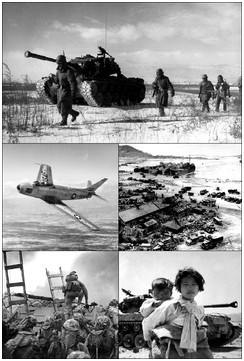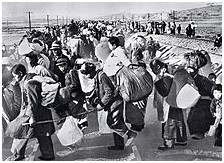

The Korean War (Korean: 6•25 June 1950 – 27 July 1953)[28][a][30] was a war between the Republic of Korea (South Korea), supported by the United Nations, and the Democratic People's Republic of Korea (North Korea), at one time supported by the People's Republic of China and the Soviet Union. It was primarily the result of the political division of Korea by an agreement of the victorious Allies at the conclusion of the Pacific War at the end of World War II. The Korean Peninsula was ruled by the Empire of Japan from 1910 until the end of World War II. Following the surrender of the Empire of Japan in September 1945, American administrators divided the peninsula along the 38th parallel, with U.S. military forces occupying the southern half and Soviet military forces occupying the northern half.[31]
The failure to hold free elections throughout the Korean Peninsula in 1948 deepened the division between the two sides; the North established a communist government, while the South established a right-wing government. The 38th parallel increasingly became a political border between the two Korean states. Although reunification negotiations continued in the months preceding the war, tension intensified. Cross-border skirmishes and raids at the 38th Parallel persisted. The situation escalated into open warfare when North Korean forces invaded South Korea on 25 June 1950.[32] In 1950, the Soviet Union boycotted the United Nations Security Council. In the absence of a veto from the Soviet Union, the United States and other countries passed a Security Council resolution authorizing military intervention in Korea.
The U.S. provided 88% of the 341,000 international soldiers which aided South Korean forces, with twenty other countries of the United Nations offering assistance. Suffering severe casualties within the first two months, the defenders were pushed back to the Pusan perimeter. A rapid U.N. counter-offensive then drove the North Koreans past the 38th Parallel and almost to the Yalu River, when the People's Republic of China (PRC) entered the war on the side of North Korea.[32] Chinese intervention forced the Southern-allied forces to retreat behind the 38th Parallel. While not directly committing forces to the conflict, the Soviet Union provided material aid to both the North Korean and Chinese armies. The fighting ended on 27 July 1953, when the armistice agreement was signed. The agreement restored the border between the Koreas near the 38th Parallel and created the Korean Demilitarized Zone (DMZ), a 2.5-mile (4.0 km)-wide fortified buffer zone between the two Korean nations. Minor incidents still continue today.
From a military science perspective, the Korean War combined strategies and tactics of World War I and World War II: it began with a mobile campaign of swift infantry attacks followed by air bombing raids, but became a static trench war by July 1951.
Factors in U.S. intervention
The Truman administration was caught at a crossroads. Before the invasion, Korea was not included in the strategic Asian Defense Perimeter outlined by Secretary of State Acheson.[124] Military strategists were more concerned with the security of Europe against the Soviet Union than East Asia. At the same time, the Administration was worried that a war in Korea could quickly widen into another world war should the Chinese or Soviets decide to get involved as well.
One facet of the changing attitude toward Korea and whether to get involved was Japan. Especially after the fall of China to the Communists, "Japan itself increasingly appeared as the major East Asian prize to be protected". U.S. East Asian experts saw Japan as the critical counterweight to the Soviet Union and China in the region. While there was no United States policy that dealt with South Korea directly as a national interest, its proximity to Japan pushed South Korea to the fore. "The recognition that the security of Japan required a non-hostile Korea led directly to President Truman's decision to intervene.The essential point is that the American response to the North Korean attack stemmed from considerations of US policy toward Japan."[125] The U.S. was working to shore up Japan which was its protectorate.

Hundreds of thousands of South Koreans fled south in mid-1950 after the North Korean army invaded
The other important part of committing to intervention lay in speculation about Soviet action in the event that the U.S. intervene. The Truman administration was fretful that a war in Korea was a diversionary assault that would escalate to a general war in Europe once the U.S. committed in Korea. At the same time, "[t]here was no suggestion from anyone that the United Nations or the United States could back away from [the conflict]".
[126] In Truman's mind, this aggression, if left unchecked, would start a chain reaction that would destroy the United Nations and give the go ahead to further Communist aggression elsewhere. Korea was where a stand had to be made; the difficult part was how. The UN Security Council approved the use of force to help the South Koreans and the U.S. immediately begin using air and naval forces in the area to that end. The Administration still refrained from committing on the ground because some advisors believed the North Koreans could be stopped by air and naval power alone.[127]
It was still uncertain if this was a clever ploy by the Soviet Union to catch the U.S. unawares or just a test of U.S. resolve. The decision to commit ground troops and to intervene eventually became viable when a communiqué was received on 27 June from the Soviet Union that alluded it would not move against U.S. forces in Korea. "This opened the way for the sending of American ground forces, for it now seemed less likely that a general war—with Korea as a preliminary diversion—was imminent".[128] With the Soviet Union's tacit agreement that this would not cause an escalation, the U.S. now could intervene with confidence that other commitments would not be jeopardized.



















